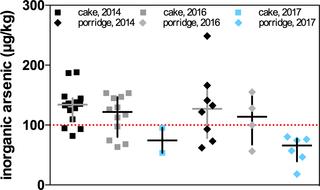PLOS ONE ( IF 2.9 ) Pub Date : 2018-03-16 , DOI: 10.1371/journal.pone.0194700 Manus Carey 1 , Emily Donaldson 1 , Antonio J Signes-Pastor 1, 2 , Andrew A Meharg 1

|
There has been an increasing realisation that young infants are exposed to elevated concentrations of the carcinogen inorganic arsenic, relative to adults. This is because many infant food products are rice based, and rice is ~10-fold elevated in inorganic arsenic compared to most other foods. The European Commission (EC) has acted on this concern setting stricter standards for infants, 100 μg of inorganic arsenic per kg of food (100 μg/kg), as compared to adults (200 μg/kg), for rice based foods, a law that was brought into place in 1st January 2016. Here we investigate how this law has impacted on inorganic arsenic in baby food products in the UK market, and compare the findings to previous baby food surveys taken before and just after the law came into place. We find that for a wide range of UK infant products that the new regulations are being adhered to, with all samples surveyed, being under 100 μg/kg inorganic arsenic. The prevalence of pure rice products had decreased in the UK, and there appears to be careful sourcing of the rice used in these products to ensure conformity with regulations. There has been an increased presence of mixed cereal products, with rice and maize as the main ingredient, appearing on the UK market, with varying rice contents for infant porridges, cakes and mueslis, with the latter being a relatively innovative product for infant foods. There was a highly significant correlation (P<0.0001) between rice content and inorganic arsenic concentration across all infant foods. When UK infant rice cakes, breakfast cereals and porridges were compare to their general, i.e. not labelled specifically for being for infant consumption, equivalent it was found that the adult foods generally exceeded the 100 μg/kg inorganic arsenic standard for infant foods. Thus, infants should not be given rice products not specifically labelled as being for them if a lower inorganic arsenic diet is to be maintained.
中文翻译:

为了响应欧盟法规,用其他无麸质谷物稀释大米以降低幼儿食品中的无机砷,这推动了制定更严格的标准
人们越来越认识到,相对于成人,幼儿接触的致癌物无机砷浓度较高。这是因为许多婴儿食品都是以大米为基础的,而大米的无机砷含量比大多数其他食品高约 10 倍。针对这一问题,欧盟委员会 (EC) 已采取行动,为婴儿制定了更严格的标准,每公斤食品中无机砷含量为 100 微克 (100 微克/公斤),而成人食品中无机砷含量为 200 微克/公斤。该法律于 2016 年 1 月 1日实施。在此,我们调查该法律对英国市场婴儿食品中无机砷的影响,并将调查结果与该法律实施之前和之后进行的婴儿食品调查进行比较地方。我们发现,对于遵守新法规的多种英国婴儿产品,所有调查样品的无机砷含量均低于 100 微克/千克。英国纯大米产品的流行度有所下降,这些产品中使用的大米的采购似乎非常谨慎,以确保符合法规。英国市场上出现了越来越多以大米和玉米为主要成分的混合谷物产品,其中婴儿粥、蛋糕和麦片的大米含量各不相同,后者是婴儿食品中相对创新的产品。所有婴儿食品中大米含量与无机砷浓度之间存在高度显着相关性(P<0.0001)。当英国的婴儿米饼、早餐麦片和粥与它们的一般相比时,即 没有专门标注供婴儿食用的产品,相当于发现成人食品普遍超出了婴儿食品100微克/公斤的无机砷标准。因此,如果要维持低无机砷饮食,则不应给婴儿提供未专门标记为适合婴儿的米制品。











































 京公网安备 11010802027423号
京公网安备 11010802027423号